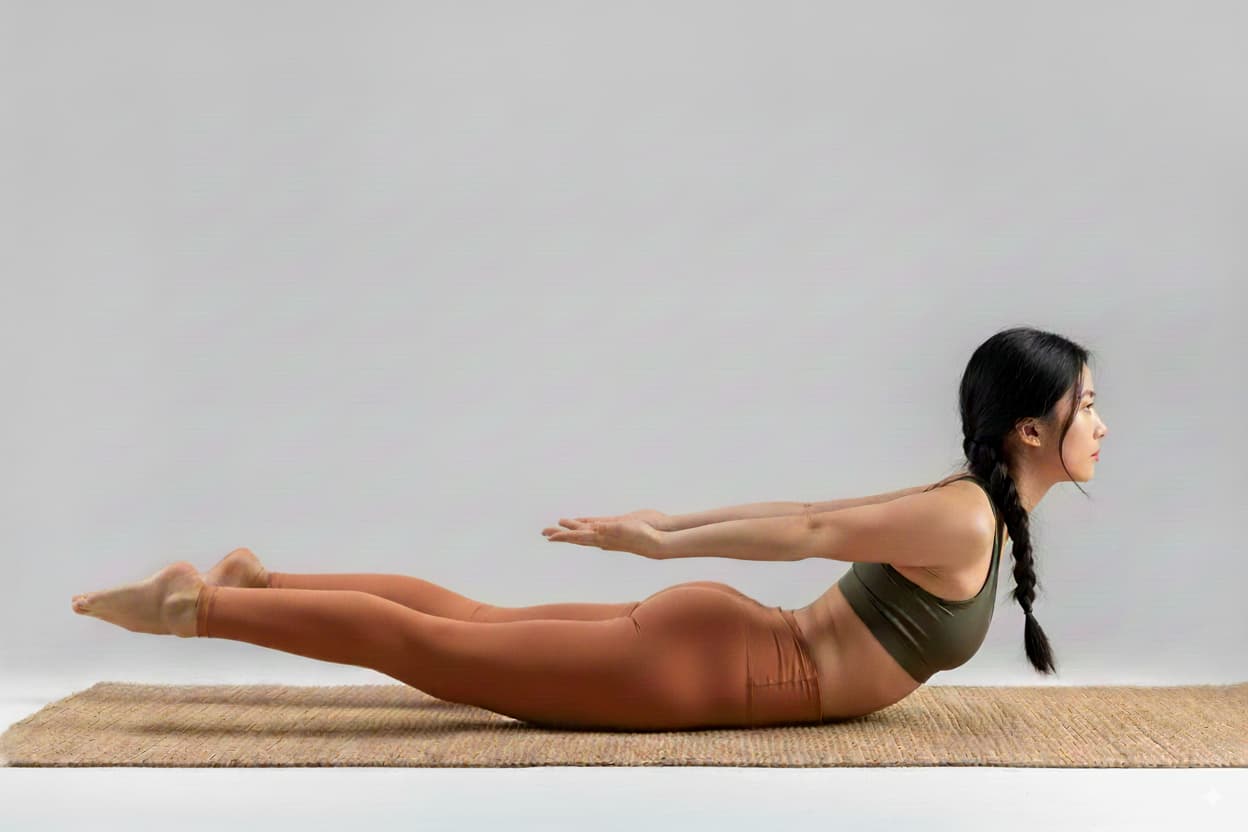Locust Pose, or Salabhasana, is a powerful backbend that strengthens the spine and revitalizes the entire body. This pose is accessible to both beginners and advanced practitioners, offering variations and modifications to suit different levels. By practicing Locust Pose, you can build core strength, improve posture, and enhance flexibility, making it a valuable addition to any yoga routine.
Other Names for Locust Yoga Pose
Known by different names across diverse yoga traditions, Locust Pose is also referred to as:
- Salabhasana (Sanskrit)
- Grasshopper Pose
How to do Locust Pose in Yoga
Follow these steps to gracefully enter Locust Pose:
- Start prone: Begin by lying on your stomach with your legs extended and the tops of your feet resting on the mat.
- Place your arms: Position your arms alongside your body, with your palms facing up.
- Engage your core: Activate your abdominal muscles to support your lower back.
- Lift your legs: Inhale as you gently lift your legs off the mat, keeping them straight and engaged.
- Lift your upper body: Simultaneously lift your upper body, including your chest and arms, off the mat.
- Extend and reach: Reach back through your fingertips while elongating your spine and lifting your legs higher.
- Hold the pose: Maintain the pose for 15-30 seconds, breathing deeply and consistently.
- Release with care: Exhale as you carefully lower your chest and legs back down, resting on the mat.
Variations of Locust Yoga Pose
Explore different variations of Locust Pose in yoga to add depth and variety to your practice:
- One-Legged Locust: Lift and extend one leg at a time, alternating between legs.
- Archer Locust: Extend one arm forward while reaching the opposite leg back, creating a dynamic archer-like shape.
Modifications for Locust Yoga Pose
For a more accessible experience, consider these modifications:
- Locust Arms Only: Focus on lifting and extending the upper body while keeping the legs grounded.
- Supported Locust: Place a folded blanket or bolster under the pelvis for added support.
Contraindications for Locust Pose in Yoga
While Locust Pose is generally safe for most practitioners, individuals with the following conditions should approach the pose with caution:
- Recent Abdominal Surgery: If you’ve had recent abdominal surgery, consult with a healthcare professional before attempting Locust Pose.
- Lower Back Issues: Individuals with chronic lower back issues should approach the pose mindfully and may opt for modifications.
Tips to Improve Locust Yoga Pose in Your Practice
- Focus on Lift: Prioritize lifting both the upper and lower body simultaneously, creating balance and symmetry.
- Activate the Legs: Engage the muscles in your legs, particularly the glutes and hamstrings, to enhance the lift.
- Extend through the Fingertips: Reach back through your fingertips to elongate the spine and open the chest.
What Muscles Does Locust Pose Work?
Locust Pose engages various muscle groups, including:
- Erector Spinae: Activated to lift and extend the spine.
- Glutes and Hamstrings: Engaged to lift and support the legs.
- Rhomboids and Deltoids: Involved in lifting and opening the chest.
Mental and Emotional Benefits of Locust Pose in Yoga?
Beyond its physical impact, Locust Pose in yoga offers mental and emotional advantages:
- Energy and Vitality: The pose stimulates and invigorates the entire body, fostering a sense of energy and vitality.
- Confidence: Mastering Locust Pose builds confidence, as the practitioner experiences the strength and resilience of their body.
Is Locust Yoga Pose Suitable for Beginners?
Locust Pose is accessible for beginners, offering an opportunity to build strength in the back and legs.
Is Locust Yoga Pose Suitable for Advanced Practitioners?
Advanced practitioners can deepen the pose by exploring variations and incorporating it into more dynamic sequences.
How Does Locust Pose Contribute to a Yoga Sequence or Flow?
Locust Pose seamlessly integrates into a yoga sequence in the following ways:
- Strength Building: Used as a strength-building pose to prepare the body for more advanced backbends.
- Heart Opening: Contributes to heart-opening sequences, encouraging practitioners to lift and expand through the chest.
- Balancing Energy: Balances and counteracts forward bends and inversions by creating a backbending element.
How Can I Deepen My Practice in Locust Pose?
Deepening your practice in Locust Pose involves:
- Continuous Engagement: Maintain consistent engagement in the muscles throughout the pose, from the legs to the upper body.
- Exploring Variations: Gradually explore different variations of Locust Pose, such as One-Legged Locust or Archer Locust.
- Incorporating into Sequences: Integrate Locust Pose into your regular practice to build endurance and familiarity.
Common Mistakes in Teaching Locust Yoga Pose
To ensure a safe and effective practice, avoid these common teaching mistakes when guiding students in Locust Pose:
- Overlooking Core Engagement: Emphasize the importance of engaging the core to provide support for the lower back.
- Neglecting Balanced Lift: Encourage students to lift both the upper and lower body simultaneously to create balance.
- Forgetting Breath Awareness: Remind practitioners to maintain steady and mindful breathing throughout the pose.
In conclusion, Locust Pose in yoga stands as a testament to the strength and resilience within each practitioner. As you lift and expand in this backbend, let the energy flow through your body, invigorating both body and mind. Whether you’re just starting your yoga journey or have been practicing for years, Locust Pose is a call to rise, strengthen, and embrace the transformative power of Salabhasana. Inhale deeply, lift higher, and embody the grace and strength of the grasshopper.
Namaste.
What is the Locust Pose good for?
The Locust Pose is good for strengthening the lower back, improving posture, and enhancing core stability. Commonly used in Hatha and Vinyasa yoga, this backbend engages the spinal extensors, glutes, and hamstrings, making it effective for relieving lower back tension and increasing muscular endurance.
Why is Locust Pose so hard?
Locust Pose is challenging because it requires significant strength and coordination in the lower back, glutes, and hamstrings. It also demands core stability and shoulder engagement to lift the chest while keeping the legs elevated. This pose, or Salabhasana, tests spinal extension and body awareness, making it difficult for beginners in Hatha or Vinyasa yoga.
What is the most slimming pose?
The most slimming pose is commonly the Locust Pose (Salabhasana), which strengthens the lower back, tones the abdominal muscles, and improves posture. Practicing this yoga pose, along with related core-focused movements like Plank Pose and Bridge Pose, can help create a leaner appearance over time.
What are common mistakes in Locust Pose?
Common mistakes in Locust Pose include overstraining the lower back, holding the breath, and lifting the head too high, which can cause neck tension. Proper alignment involves engaging the glutes, activating the core, and lengthening through the spine. Tools like yoga blocks or props can assist in maintaining correct form.

